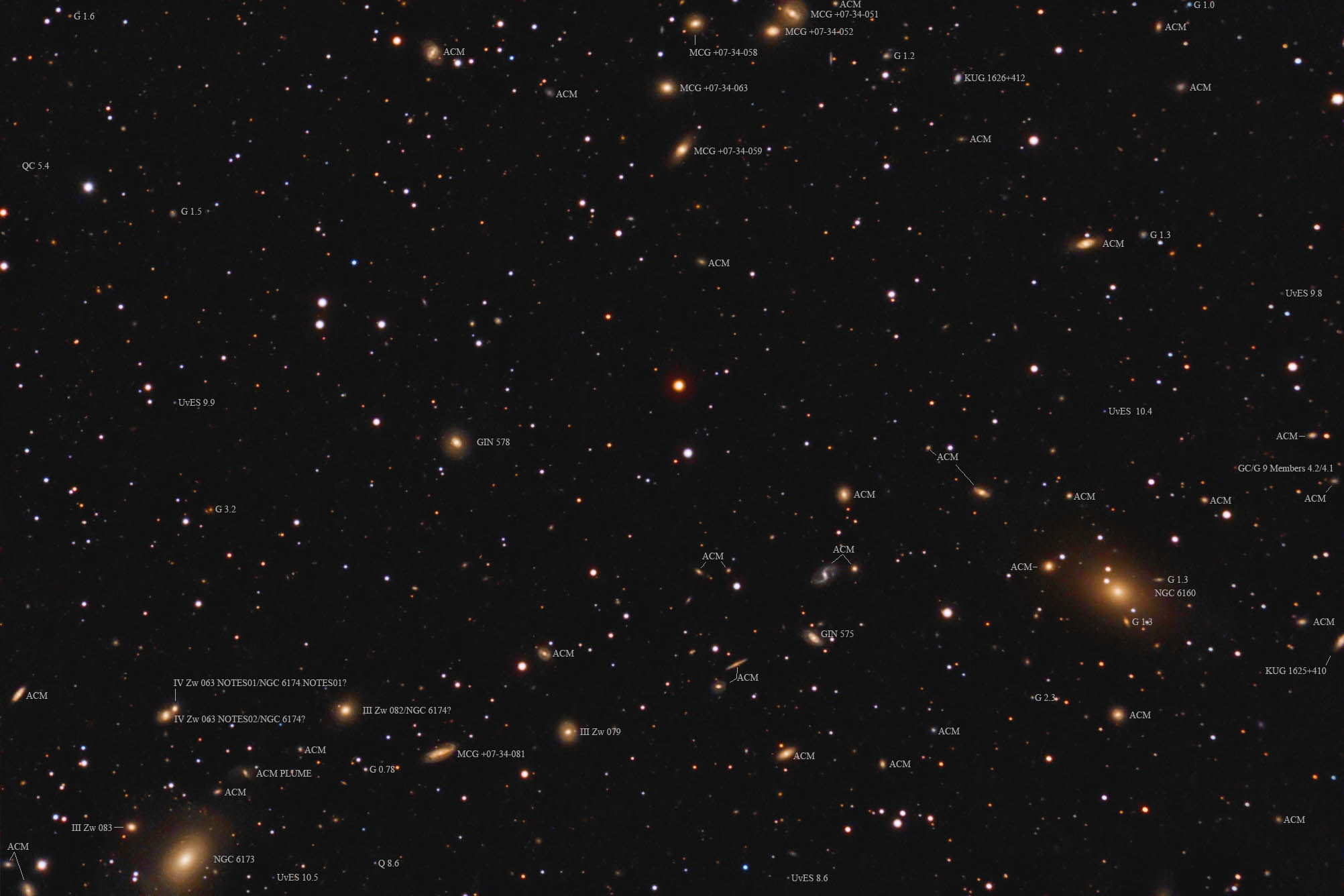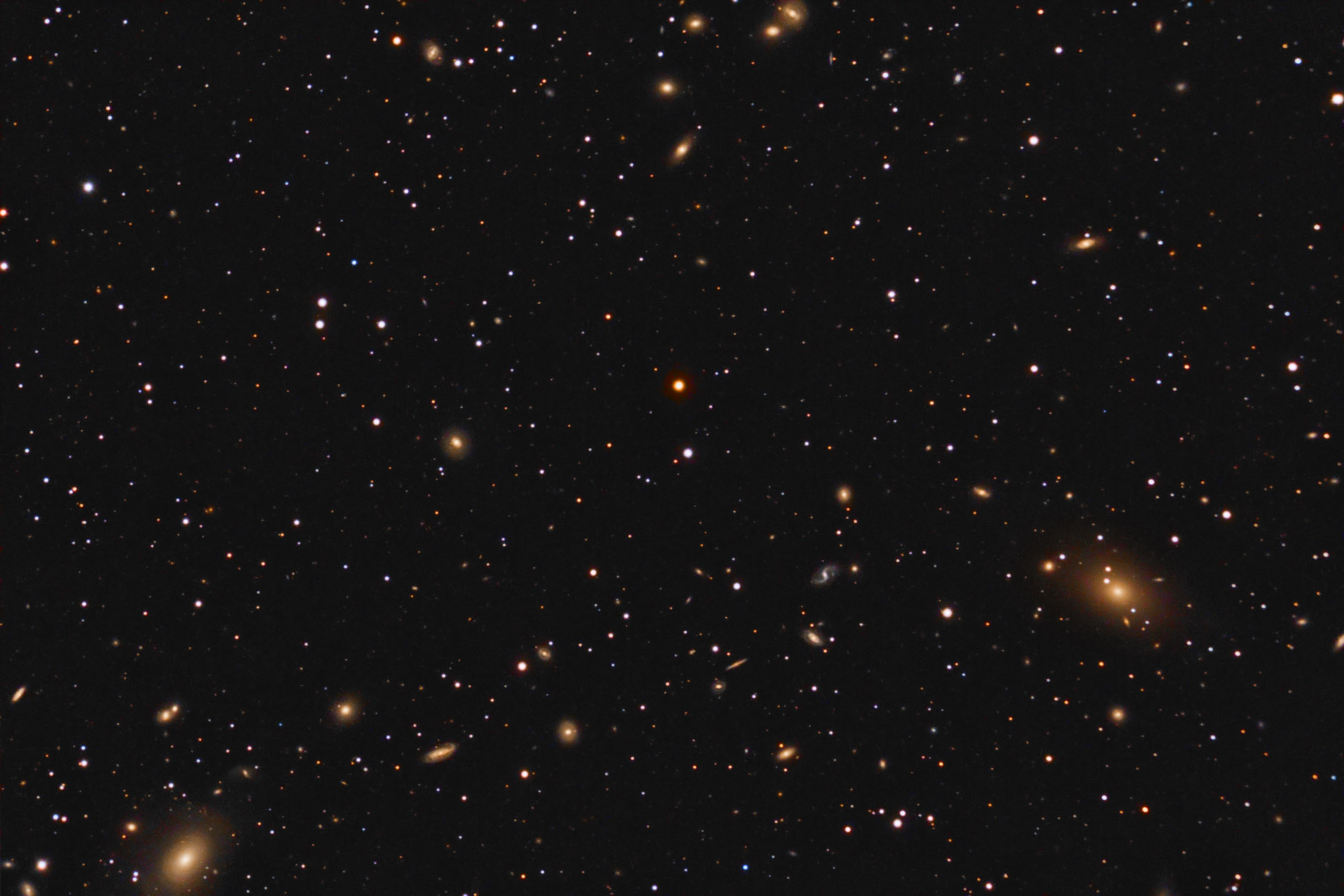| Description | Images |
Object name: ABELL2197Designation(s): ABELL2197, NGC6160, NGC6173, NGC6174, Abell 2197 is a moderately condensed galaxy cluster containing over 50 galaxies, most "big and bright" at least compared to most Abell clusters. It too is too large for my field but I was able to capture much of it. It is about 420 million light-years from our galaxy and located in Hercules, just not THE Hercules Galaxy cluster which is Abel 2151. The cluster is rather linear in nature with two widely spaced large elliptical cD galaxies, each the center of a portion of the cluster designated as Abell 2197E and 2197W. Related Designation(s):18W 005, 18W 008, 1RXS J162741.8+405536, 1RXS J162944.5+404843, 2MASS J16274111+4055370, 2MASS J16294489+4048419, 2MASX J16274107+4055368, 2MASX J16294485+4048421, 2MASXi J1627410+405536, 2XMM J162741.1+405537, 2XMM J162944.8+404842, 2XMMp J162741.1+405537, 2XMMp J162944.8+404841, ABELL 2197, ABELL 2197:[BTM97] 1, ABELL 2197:[BTM97] 2, ABELL 2197:[CBW93] A, ABELL 2197:[CBW93] B, ABELL 2197:[DGP89] 0016/7JTR , ABELL 2197:[DGP89] 1753/7JBL , ABELL 2197:[PL95] BCG, ABELL 2197:[PL95] G2, ABELL 2199:[HIV2012] 0197, ABELL 2199:[HIV2012] 0426, ABELL2197, ASK 164944.0, ASK 165389.0, B2 1621+38:[HIV2012] 0085, B2 1621+38:[HIV2012] 0155, CALIFA 840, CAN 065, CAN 065 NED01, CAN 065 NED02, CGCG 1626.0+4102, CGCG 1628.1+4055, CGCG 224-032, CGCG 224-049, CGPG 1628.1+4059, CID 65, FIRST J162741.1+405537, FIRST J162944.8+404841, GIN 562, GIN 563, HDCE 0952 NED001, HOLM 753A, IV Zw 063, LDCE 1190 NED020, MCG +07-34-042, MCG +07-34-083, Mr18:[BFW2006] 04792 NED237, Mr18:[BFW2006] 04792 NED97, Mr19:[BFW2006] 09501 NED145, Mr19:[BFW2006] 09501 NED68, Mr20:[BFW2006] 16089 NED23, Mr20:[BFW2006] 16089 NED65, NGC 6160, NGC 6173, NGC 6174, NGC 6174 NED02, NGC6160, NGC6173, NGC6174, NSA 029530, NSA 029682, NVSS J162944+404842, PGC 058191, PGC 058199, PGC 058348, RX J1627.6+4055, RX J1627.6+4055:[BEV98] 003, RX J1627.6+4055:[ZEH2003] 03 , RX J1627.7+4055, RX J1629.7+4048, SCL 160 NED11, SDSS J162741.11+405537.0, SDSS J162741.12+405537.0, SDSS J162741.12+405537.1, SDSS J162741.13+405537.0, SDSS J162741.13+405537.2, SDSS J162944.87+404841.9, SDSS J162944.88+404841.9, SDSS J162944.91+404841.7, SDSS J162944.99+404841.7, UGC 10400, UGC 10421, USGC U766 NED11, USGC U766 NED32, UZC J162741.1+405537, UZC J162944.9+404842, WBL 618-001, WISE J162741.13+405537.1, WISE J162944.90+404841.8, ZwCl 1625.5+4006 NED01, [BFW2006] J246.92138+40.92696 , [BFW2006] J247.43699+40.81165 , [BKH2005] 0816-184, [DZ2015] 769-01, [DZ2015] 772-01, [GMM2009] 0395749, [GMM2009] 0701900, [HIV2012] 1051, [HIV2012] 1280, [HIV2012] 5353, [HIV2012] 5423, [LHL2015] 0207, [LHL2015] 0344, [M98j] 252 NED02, [MO2001] J162944.9+404840.6, [TTL2012] 402759, [TTL2012] 404956, |

